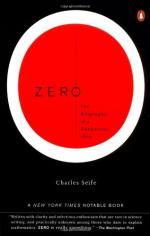
|
| Name: _________________________ | Period: ___________________ |
This test consists of 15 multiple choice questions and 5 short answer questions.
Multiple Choice Questions
1. The author notes in Chapter 6, “Infinity's Twin” that multiplying zero or infinity by itself equals what?
(a) Itself.
(b) One.
(c) Its inverse.
(d) Its negative.
2. The author says in Chapter 6, “Infinity’s Twin” that by employing the concept of infinity, Johannes Kepler showed that ellipses and what were the same?
(a) Derivatives.
(b) Tangents.
(c) Limits.
(d) Parabolas.
3. What term refers to an elementary particle, the quantum of light and all other forms of electromagnetic radiation?
(a) Radon.
(b) Electron.
(c) Photon.
(d) Nucleus.
4. What term refers to a branch of pure mathematics devoted primarily to the study of the integers?
(a) Algebra.
(b) Classical physics.
(c) Geometry.
(d) Number theory.
5. What term in theoretical physics refers to an extension of string theory in which 11 dimensions of spacetime are identified?
(a) Space theory.
(b) Big Bang theory.
(c) Planck theory.
(d) M-theory.
6. The author asserts in Chapter 6, “Infinity's Twin” that with the introduction of imaginary numbers, the fundamental theorem of what mathematical branch was discovered?
(a) Geometry.
(b) Algebra.
(c) Quantum physics.
(d) Thermodynamics.
7. The antiparticle of the electron is called what?
(a) Proton.
(b) Positron.
(c) Neutron.
(d) Derivative.
8. What term refers to numbers that are "infinite" in the sense that they are larger than all finite numbers, yet not necessarily absolutely infinite?
(a) Pythagorean numbers.
(b) Transfinite numbers.
(c) Quantitative numbers.
(d) Derivative numbers.
9. What is the study of geometric properties that are invariant under projective transformations?
(a) Classical relativity.
(b) Projective algebra.
(c) Projective geometry.
(d) General relativity.
10. In mathematics, the cardinality of a set is a measure of what?
(a) The number of possible derivatives of the set.
(b) The inverse quality of the set.
(c) The number of elements of the set.
(d) The quantity of the number of the set combined.
11. What term refers to a physical constant that is the quantum of action in quantum mechanics?
(a) The Pythagorean theorem.
(b) The Planck constant.
(c) M-Theory.
(d) The Golden Ratio.
12. Johannes Kepler used calculus to determine that planets had what, according to the author in Chapter 5, “Infinite Zeros and Infidel Mathematicians”?
(a) Circular orbits.
(b) Movement.
(c) Circular movement.
(d) Elliptical orbits.
13. Carl Gauss referred to mathematics as what?
(a) “The end of science.”
(b) “The queen of sciences.”
(c) “The key to philosophy.”
(d) “Theology’s twin.”
14. Newton's notation for differentiation uses what symbol placed over a function name to denote the time derivative of that function?
(a) An omega.
(b) A dot.
(c) An omicron.
(d) A line.
15. What mathematical term refers to a function that preserves distinctness by never mapping distinct elements of its domain to the same element of its codomain?
(a) Injective function.
(b) Bijective function.
(c) Derivative function.
(d) Differential equation.
Short Answer Questions
1. The absolute value of a number may be thought of as its distance from what?
2. A primary difficulty in the creation of a “Theory of Everything” is that most attempts to apply quantum mechanics to the gravitational field in the same way as for the electromagnetic field fails due to the breakdown of what?
3. In what year did Albert Einstein publish a paper that explained experimental data from the photoelectric effect, leading to the quantum revolution?
4. Bernhard Riemann was able to show how to generate the geometry for what, according to the author in Chapter 6, “Infinity’s Twin”?
5. The mass of an electron is represented by what fraction in comparison with the mass of a proton?
|
This section contains 534 words (approx. 2 pages at 300 words per page) |

|




